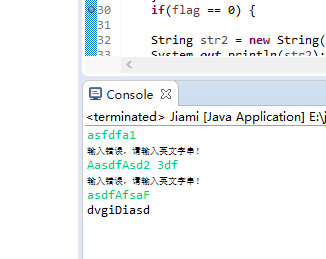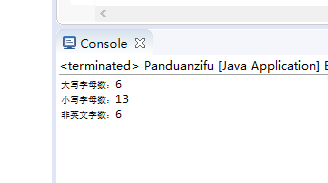第五周总结&第三次实验报告
实验三 String类的应用
实验目的
掌握类String类的使用;
学会使用JDK帮助文档;
实验内容
1.已知字符串:"this is a test of java".按要求执行以下操作:(要求源代码、结果截图。)
统计该字符串中字母s出现的次数。
统计该字符串中子串“is”出现的次数。
统计该字符串中单词“is”出现的次数。
实现该字符串的倒序输出。
实验代码
public class Example1 {
public static void main(String args[]) {
String str = new String("this is test of java");
System.out.println("含有S的个数:"+Fangfa1(str));
System.out.println("is的字串:"+Fangfa2(str));
System.out.println("单词is的个数"+Fangfa3(str));
Fangfa4("倒序输出字符串"+str);
}
public static int Fangfa1(String str) {
int count1 = 0;
char c[] = str.toCharArray();
for(int i = 0; i < c.length;i++) {
if(c[i] == 's') {
count1++;
}
}
return count1;
}
public static int Fangfa2(String str) {
int count2 = 0;
char c[] = str.toCharArray();
for(int i = 0; i < c.length;i++) {
if(c[i] == 's' && c[i - 1] == 'i') {
count2++;
}
}
return count2;
}
public static int Fangfa3(String str) {
int count3 = 0;
String c[] = str.split(" ");
for(int i = 0;i < c.length ; i++) {
if(c[i].equals("is")) {
count3++;
}
}
return count3;
}
public static void Fangfa4(String str) {
String c[] = str.split(" ");
for(int i = c.length - 1; i > 0;i--) {
System.out.print(c[i] + " ");
}
}
}
实验结果

2.请编写一个程序,使用下述算法加密或解密用户输入的英文字串。要求源代码、结果截图。

实验代码
import java.util.*;
public class Jiami {
public static void main(String args[]) {
Scanner in= new Scanner(System.in);
String str = in.nextLine();
char c[] = str.toCharArray();
for(int i = 0; i< c.length;i ++) {
c[i] = (char) (c[i] + 3);
}
String str2 = new String(c);
System.out.println(str2);
in.close();
}
}
实验结果

更改版
import java.util.*;
public class Jiami {
public static void main(String args[]) {
Scanner in= new Scanner(System.in);
int i,flag = 0;
while(true) {
String str = in.nextLine();
char c[] = str.toCharArray();
for(i = 0;i < c.length;) {
if(c[i] < 'A' ||c[i] > 'Z' && c[i] < 'a' || c[i] > 'z') {
System.out.println("输入错误,请输入英文字串!");
flag = 1;
break;
}
i++;
}
char d[] = {c[0],c[1],c[2]};
int j = 0;
for(i = 0; i< c.length;i ++) {
if(i >= c.length - 3) {
c[i] = (char)(d[j]);
j++;
}
else
c[i] = (char) (c[i] + 3);
}
if(flag == 0) {
String str2 = new String(c);
System.out.println(str2);
break;
}
flag = 0;
}
in.close();
}
}
结果

3.已知字符串“ddejidsEFALDFfnef2357 3ed”。输出字符串里的大写字母数,小写英文字母数,非英文字母数。
实验代码
public class Panduanzifu {
public static void main(String args[]) {
String str = "ddejidsEFALDEfnef2357 3ed";
char c[] = str.toCharArray();
int count1 = 0, count2 = 0, count3 = 0;
for(int i = 0;i < c.length;i ++) {
if((int)c[i] >= 65 & (int)c[i] <= 90)
count1++;
if((int)c[i] >= 97 & (int)c[i] <= 122) {
count2++;
}
if((int)c[i] < 65 || (int)c[i] > 90 & (int)c[i] < 97 || (int)c[i] > 122) {
count3++;
}
}
System.out.println("大写字母数:"+count1);
System.out.println("小写字母数:"+count2);
System.out.println("非英文字数:"+count3);
}
}
实验结果

实验总结
这次实验主要是字符串的处理,大体过程没什么难度,就是统计单词is的时候,单词数为零,后来一想,直接比较是比较地址,用了equals后就没问题了。实验虽然简单,但是更加让我对字符串的处理更加得心应手。
第五周总结
本周主要讲了Java的第二个特性,继承性,final关键字进一步讲解了多态性,对象的多态,

注意:Java中只允许单继承,不允许多继承,即一个子类只能继承一个父类,可以多层继承,即一个子类可以有一个父类,一个父类还可以有一个父类。
继承的子类有时也被叫做派生类,extends本身含义为扩展,就是扩展父类的内容
注意:子类不能直接访问父类私有成员,可以调用非私有方法,可以间接调用私有成员,例如setter,getter。
子类对象在实例化之前会先默认调用父类中的构造方法,所以实例化子类对象之前,需要先将父类中的属性进行初始化,在子类中隐含了一个super()方法。
super()表示子类可以直接调用父类中的无参构造。
覆写:
存在子类继承父类中。
主意:子类中覆写的方法不能有比父类更严格的权限。

super关键字:
前面已经提到super可以直接调用父类中的方法。
super调用构造方法与this一样,super要方法子类构造方法的首行
super与this很相似,都是可以调用构造,普通方法,属性,但是两者还是有一点区别。

final关键字:
final在Java中表示最终的意思,可以使用final声明类,属性,方法
注意:
- 使用final声明的类不能有子类。
- 使用final声明的方法不能被子类覆写。
- 使用final声明的变量即成为常量,常量不可以修改。
final变量命名时要求全部大写。
抽象类:
抽象类是Java专门提供一种当父类的类
抽象类的定义和命名规则: - 包含一个抽象方法的类必须是抽象类。
- 抽象类和抽象方法都要使用abstract关键字声明;
- 抽象方法只须声明不需要实现。
- 抽象类必须被子类继承,子类如果不是抽象类那么必须要覆写抽象类的全部抽象方法。

抽象类不能使用final关键字声明,因为抽象类必须被继承,必须被覆写。
抽象类可以定义构造方法
抽象类实际上就是比普通类多了一个抽象方法,除此之外没有很大的区别。
多态:
一种是的方法的重载与覆写
另一种是对象的多态
对象的多态主要是两种类型

向上转型,程序会自动完成,向下转型,必须要明确转型的子类类型
向下转型前必须先发生向上转型。
主要作用





